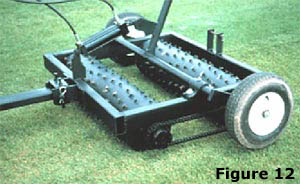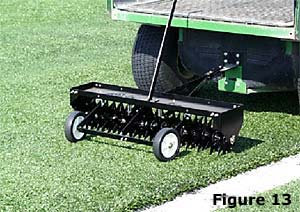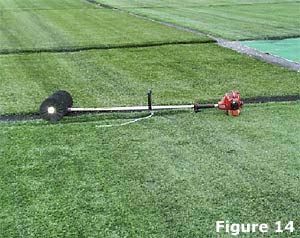
We began to impose simulated foot traffic during July of 2003. Traffic was applied using a Brinkman traffic simulator (Cockerham and Brinkman, 1989). The Brinkman Traffic Simulator weighs 410 kg and consists of a frame housing two 1.2-m long rollers (Fig. 12). Each roller has steel dowels or spriggs (12.7-mm diameter by 12.7-mm length) welded to the outside of the rollers, at an average of 150 dowels m -2 . These dowels are the approximate length and width of the cleats on the shoe of an American football lineman at the collegiate level. The Brinkman Traffic Simulator produces wear, compaction, and lateral shear. The drive thrust yielding lateral shear is produced by different sprocket sizes turning the rollers at unequal speeds. The Brinkman Traffic Simulator was pulled with a model 4200VXD Ventrac tractor (Venture Products, Inc. Orrville, OH) equipped with a dual turf tire package.
Plots were split with two levels of traffic. The traffic levels were no wear, and high wear (eight passes three times per week). According to Cockerham and Brinkman (1989), two passes of the Brinkman Traffic Simulator produces the equivalent number of cleat dents created between the hash marks at the 40-yard line during one National Football League game. Thus, 24 passes per week are equivalent to the cleat dents sustained from 12 games per week.

Traffic began on 7 Jul 2003 and 21 April 2004. Typically, traffic was applied regardless of weather conditions or water content of the infill. Numerous traffic applications occurred when the plots were very wet. Occasionally, due to heavy precipitation or schedule conflicts, traffic was not applied on the scheduled day. In these cases, traffic was applied on the following day.
In order to collect data, traffic was not applied for an approximately 3-week period at the end of July through early August in 2003 and 2004. Traffic resumed in mid August of each year and continued until 9 Oct 2003 and 8 Nov 2004. Plots were groomed on 9 Oct 2003 and again on 4 Aug 2004. Grooming consisted of loosening the granules using a 40" Lawn aerator (model # 45-0296 Agri-fab, Inc. Sullivan, IL) shown in Fig. 13.

Two passes with the lawn aerator were applied on each half of each plot with the second pass being 90° to the first. Following loosening of the granules, the pile above the infill material was broomed using a hand held power broom (Fig. 14) to try to return the pile to an upright position. Data collection again occurred during the week after grooming was complete.

